Leaked letter reveals internal concerns about science on Australia’s next world heritage site

- by Admin
- June 5, 2024

Some of the state’s biggest companies run operations just metres from the artworks, including Woodside, Rio Tinto and fertiliser giant Yara.
The proximity of these operations has prompted studies on whether their chemical emissions are eroding the art, but there is still no scientific consensus.
The monitoring program began four years ago and forms a key plank in the federal government’s current application to UNESCO to turn the site into a World Heritage Listed area.
The state Department of Water and Environmental Regulation has control of the program but has contracted mining and environmental services firm Calibre to carry out the work.
Calibre in turn has subcontracted Curtin University to carry out the monitoring, with Murujuga Aboriginal Corporation due to take over in 2026.
The former Aboriginal corporation employee also lashed Curtin, writing in the letter that the university had sent a “contractor to Murujuga who demonstrated low capability and committed a major error in relation to the sample collection and sample processing protocol.”
The Department, the Aboriginal corporation and Curtin all disagreed with concerns in the employee letter.
Murujuga Aboriginal Corporation chief executive Kim Wood said they were an active leader in the monitoring program with rangers heavily involved in fieldwork.
He said the Murujuga Circle of Elders, the corporation’s board and senior heritage advisors had close oversight of all the scientific work and were regularly briefed on findings.
“The claims made in the tabled documents do not stand up to scrutiny,” he said.
“The Murujuga rock art monitoring program is a strong, best-practice program that has been designed with international experts to examine the impact of industrial emissions on Murujuga’s petroglyphs.”
A department spokesman said the letter’s claims were factually incorrect, and further said the department placed great importance on continuing its positive and productive relationship with Murujuga Aboriginal Corporation, which received public funding for its involvement.
“Every aspect of the monitoring program is respectfully co-designed and informed by the cultural law, knowledge and practices of the Traditional Owners and Custodians of Murujuga, guided by the Circle of Elders,” the spokesman said.
“The state government has committed to making the results of the monitoring program publicly available, following independent peer review and data validation.”
The Department spokesman said Murujuga rangers were undergoing monitoring training through “micro-credential” training units.
A Curtin University spokeswoman said there were more than 50 researchers involved in the program, including contractors, and all passed a rigorous, competitive selection process.
She said they included some of the world’s foremost researchers in their respective fields, including three Australian Academy of Science fellows, a recent WA Scientist of the Year, and a runner-up Young Scientist of the Year.
“The contract requires the project chief statistician to approve all study designs, analyses and reports,” she said.
Loading
“All methods and data arising from the program undergo rigorous development, quality assurance and control, followed by an external independent peer review, prior to publication.”
Environment Minister Reece Whitby said the precautionary principle was applied to all management responses.
The world heritage committee formally accepted the federal government’s nomination of Murujuga in March and it has been referred to the International Council on Monuments and Sites.
Council members will visit the site as part of the assessment process and a decision is expected next year.
Murujuga could become the second Australian world heritage listed site for First Nations cultural heritage after the Budj Bim Cultural Landscape was listed in 2019.
Former Murujuga Aboriginal Corporation chair and Save our Songlines spokeswoman Raelene Cooper said the letter vindicated and validated the concerns Save Our Songlines had expressed for years about the rock art and the need for independent oversight of the monitoring program.
“How many investigations and inquiries will it take to show what we already know – the voices of traditional custodians are being silenced about what happens on our Country,” the Mardudhunera woman said.
Calibre did not respond to requests for comment.
The Latest News
-
January 10, 2025Novak Djokovic: Ten-time champion deflects questions on poisoning claims at 2022 Australian Open
-
January 10, 2025Aussies arrive at Melbourne Park with big ambitions
-
January 10, 2025Tennis: How to watch Coco Gauff at the Australian Open 2025 – full schedule
-
January 10, 2025McLeod, Rudgeley lead Webex Players Series Perth – PGA of Australia
-
January 10, 2025Australian Open: Iga Swiatek felt awkward making excuses for absence during doping ban




